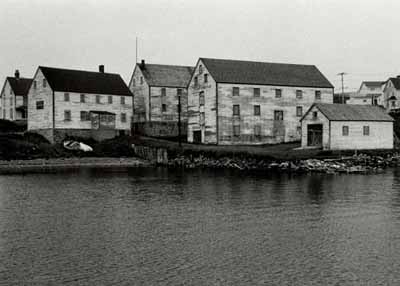Ryan Premises National Historic Site of Canada
Bonavista, Newfoundland and Labrador

Historic view
© Parks Canada Agency / Agence Parcs Canada
Address :
10 Ryans Hill Road, Bonavista, Newfoundland and Labrador
Recognition Statute:
Historic Sites and Monuments Act (R.S.C., 1985, c. H-4)
Designation Date:
1987-11-20
Dates:
-
1857 to 1952
(Construction)
-
1952 to 1978
(Significant)
-
1857 to 1952
(Significant)
Event, Person, Organization:
-
James Ryan Ltd.
(Organization)
-
James Ryan and Company
(Organization)
-
Ryan Brothers
(Organization)
Other Name(s):
-
Ryan Premises
(Designation Name)
-
Proprietor's House, Carriage House, Tenement House, Retail Shop, Retail Store, Fish Store, Salt Store
(Name of contributing resources)
Research Report Number:
1987-A02
DFRP Number:
56560
Plaque(s)
Existing plaque: 10 Ryans Hill Road, Bonavista, Newfoundland and Labrador
Marine resources were critical in shaping Atlantic Canada's human history. Aboriginal peoples fished here before the 16th century, when European mariners created a thriving international trade based on cod. In Newfoundland and Labrador, the bounty of the sea gave rise to hundreds of coastal communities (outports) and a distinctive maritime culture. Located in Bonavista, historically a prolific fishing community, the James Ryan premises is one of the last surviving examples of a 19th century mercantile complex involved in the inshore, seal and Labrador fisheries.
Description of Historic Place
Ryan Premises National Historic Site of Canada is a cultural landscape associated with the fishery. It consists of domestic and commercial structures typical of a 19th-century Newfoundland mercantile complex in their original setting by the sea, adjacent to the intersection of Ryan’s Hill and Old Catalina Road, in Bonavista.
Heritage Value
Ryan Premises was designated a national historic site of Canada in 1987 because: it was the site which best combined thematic associations with Canada’s Atlantic fisheries with extant resources; the Ryans, whose headquarters it was, were deeply involved in the whole range of the fisheries over a long time period; the richness of the fisheries-related resources in the community of Bonavista contributes to its overwhelming sense of history.
The heritage value of Ryan Premises lies in its long association with the Atlantic fishery and in its related physical resources, including the buildings in their setting in the historic community of Bonavista. The Ryan’s company was established in Bonavista in 1857 as James Ryan. Over the years, the company expanded its activities to King’s Cove (1874, as James Ryan and Company) and Trinity (1906, as Ryan Brothers) to accommodate the Labrador fishery. The company continued to engage in the salt fishery until 1978. It is now operated as a historic site open to the public.
Sources: Historic Sites and Monuments Board of Canada, Minute, May 1997; Commemorative Integrity Statement, 2002.
Character-Defining Elements
Key elements contributing to the heritage value of the site include: the setting of the complex in the historic town of Bonavista; the relationship of the built resources to each other and to the harbour; the profile and layout of the complex; the size and completeness of the complex as a typical Newfoundland mercantile outport fisheries station, particularly the diverse functions of the buildings including a Retail Shop, a Retail Store, Fish Store, Salt Store, Proprietor’s House, Carriage House, and Tenement House; the individual buildings with their rectangular massing, relatively large scale and pitched roofs, minimal detailing in response to functional requirements (varied only in the addition of a verandah and more elaborate chimney on the Proprietor’s House), use of traditional materials such as stone foundations, clapboard siding, shingle roofs, surviving evidence of their early interior layouts and original materials; the integrity, composition and presence of man-made landscape features and archaeological remnants such as garden remnants, fences, wharfs, cribbing, roads, pathways, and buildings like the fish flake, sawmill, barns, garage, telegraph office, powder magazine; the integrity, composition and presence of natural landscape features such as the pebble beach, the shore, indigenous vegetation; the integrity, composition and presence of moveable features associated with the complex including surviving domestic furnishings, retail merchandise, retail furnishings and equipment, fish processing equipment such as ropes, scales, weights, blocks, tools, fish bars and barrels; historic viewplanes between the buildings and to other buildings, remnants of buildings, structures and archaeological resources that once formed part of the complex such as the lumberyard area, remains of the cooperage, the land-side fish flake, from the complex to the sea and to sheds and other structures associated with the fishery.